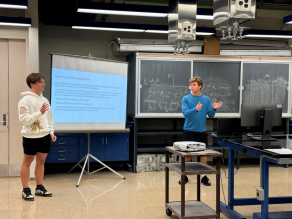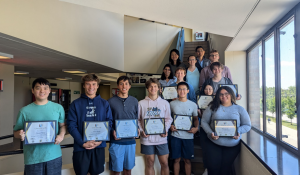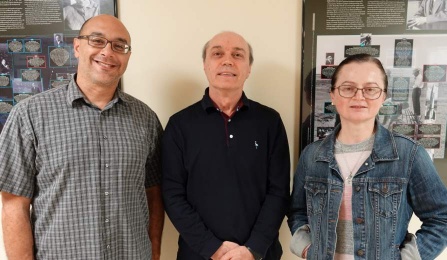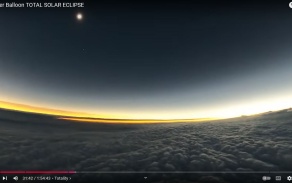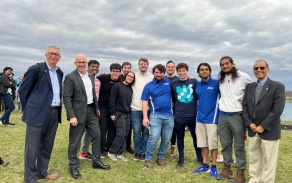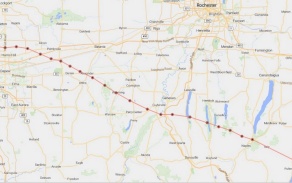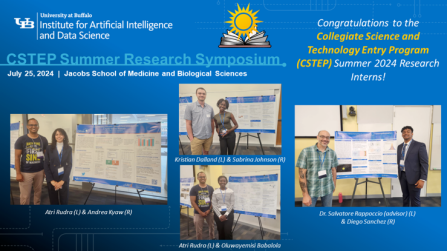
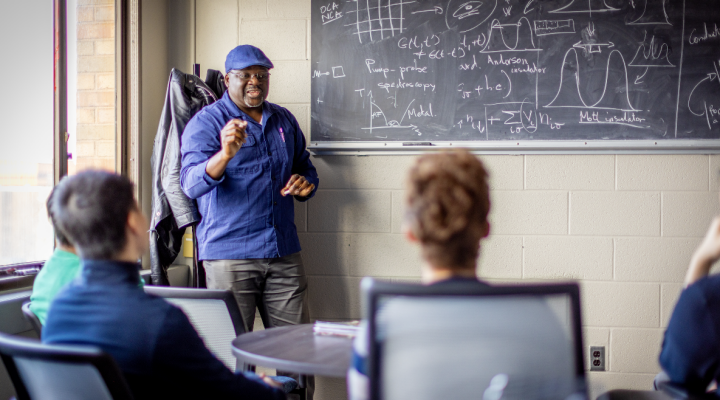
Herbert Fotso teaches in a graduate study meeting in Fronczak Hall in February 2024. Photographer: Douglas Levere
In this Issue:
Support your Department
Dear Alumni and Friends of UB Physics,
Hope you are doing great in your career and your life! The year 2024 is quickly passing into the rearview mirror. It brought us opportunities, successes, rewards, as well as challenges.
The Department has continued its growth in tenure track faculty rank this past year. In the spring of 2024, two new members joined the faculty: Associate Professor Wanyi Nie, who works on novel quantum materials, especially for energy-related applications, and Assistant Professor Dusan Sarenac, whose research specialty is in neutron scattering and quantum optics. Both have already made great progress in establishing labs and research groups. The growth will continue in January of 2025, when two Assistant Professors, Christine McLean and David Yu, who specialize in experimental particle physics, will join the Department. Then in August 2025, Jamir Marino, a condensed matter theorist who is particularly interested in cavity QED of many-body systems, will join us as an Assistant Professor. The influx of new faculty members adds more research specialties to our portfolio and will help ensure the long-term health of the Department.
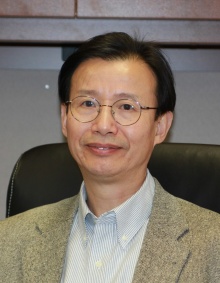
Xuedong Hu, Professor and Chair
Multiple current Physics faculty members have received external recognition and awards for their professional achievements. Professor Hao Zeng has just become our latest Fellow of the American Physical Society; Professor Priya Banerjee was named the Twenties Century Club Professor of the CAS due to his truly exceptional research productivity in terms of both publications and external funding. Indeed he became the first ever UB scholar who received a grant from the Hypothesis Fund, which focuses on supporting early stage innovative research. Professor Salvatore Rappoccio received the UB Exceptional Scholar Award for Sustained Excellence in Research for his works at LHC, and our other particle physics colleagues are taking on important leadership positions within LHC: Professor Ia Iashvili was appointed as one the Chair of the Analysis Review Committee for CMS, Professor Kharchilava was appointed the co-Chair of the CMS Publication Committee Board on Higgs Physics, while Professor Ciaran Williams was the co-Convener of the cross section working group on Higgs physics and acted as a liaison between theorists and experimentalists.
Our students, both undergraduate and graduate, are the lifeblood of the Department. Their performances in classes and in labs are the fuel to keep the professors going in their teaching and their research, and their presence in the building keeps it buzzing. Our undergraduate students have always been able to balance their academic endeavor with interesting extracurricular activities. In December 2023, our SPS Chapter won a Distinguished Chapter Award, and we also inducted Aaron D'Angelo, Charles Freeman, Lea Kyle, Dario Tringali, and Nicholas West into the Sigma Pi Sigma Physics Honor Society.
We have another large new class of graduate students joining UB Physics in the fall of 2024. This cohort of students, coming from domestic and international institutions, continue the growth trend in recent years for the Department, and add to the diversity and vibrancy to our graduate program. On October 12, led by our Director of Graduate Studies Professor Priya Banerjee, the department organized the first Graduate Research Symposium in recent memory, with about 60 attendees consisting of both faculty and students. The enthusiasm shown by our students and faculty members, as well as the wide range of research topics presented at the Symposium, are unmistakable evidence of the rich research culture we have in the Department.
This year we had two interesting public lectures. On April 8, 2024, our T.Y. Wu Lecture was given by Taekjip Ha of Harvard University, a world renowned single-molecule biophysicist and former President of the Biophysical Society. The title of his lecture is “From Single Molecules to Cellular Decision Making: Connecting the scales using mechanical force.” On October 18, our Moti Lal Rustgi Lecture was given by Professor Ivan K. Schuller from University of California San Diego, a leading expert on neuromorphic computing. The title of his talk is “Neuromorphic Computing: Developing Quantum Materials for an Energy Efficient Fault-Tolerant Computer, Inspired by the Human Brain.” With the fascination over Artificial Intelligence ever growing, and the 2024 Nobel Physics Prize just given to two original contributors to the invention of neural networks, these lectures are both eye-opening and inspiring.
As you may recall, Professor Shigeji Fujita, a long time UB Physics member, passed away late last year. In memory of his life and achievement, and to help future generations of theoretical physicists, Shigeji’s wife, Mrs. Sachiko Fujita, together with his daughters Yoshiko and Eriko Fujita, have set up an endowment to give multi-year scholarships to graduate students in the Department. Their generous contribution will help encourage students to challenge difficult research problems and carry on the torch of theoretical studies in the department.
2024 is certainly not all smooth sailing for us or for UB in general. The international politics and conflicts, such as the war in the Middle East, filter into campus life by creating tension and unrest. At the department level, we have seen international students unable to get their visas to start their studies at UB on time, and we have seen our classes affected by student demonstrations. On a longer time scale, the overall decline in enrollment at the College of Arts and Sciences, and the continued decline in the number of high school graduates in the State of New York, has been applying, and will continue to apply pressure on the Department and the University. However, with hard work, ingenuity, adaptability, and a collaborative spirit, I have no doubt that the Department will fight through whatever difficulties we face, and thrive in the years to come!
The department has seen renewed growth in recent years, in faculty, in students, in teaching and research activities, and most importantly, in excitement for what we can achieve now and in the future. We will try to keep this momentum going and continue to build a strong and vibrant department!
Please share with us stories of your work and your life. And have a great 2025!
Best wishes,
Xuedong Hu
Chair and Professor of Physics
Research News
Unconventional Anomalous Hall Effect
By Hao Zeng, PhD
The Hall effect, discovered by Edwin Hall in 1879, occurs when an electric current flows through a conductor in a perpendicular magnetic field, generating a voltage transverse to the current. This simple yet profound phenomenon has led to major advancements in physics, including the discoveries of the quantum Hall effect (1985 Nobel Prize), fractional Quantum Hall effect (1998 Nobel Prize) and topological phases of matter, resulting in a 2016 Nobel Prize.
The anomalous Hall effect (AHE) extends the Hall effect to systems without an external magnetic field, where it arises due to the intrinsic properties of the material, like spin-orbit coupling and Berry curvature. Berry curvature is a geometric property of momentum space in solid-state systems, and acts like a magnetic field to influence the motion of electrons. Thus it serves as the link between geometry and charge transport, and its manipulation can lead to novel phases and functionalities.
In a recent work done by Hao Zeng’s group and collaborators, they provide new insights for understanding the unconventional AHE observed in the 2D magnet Cr2Te3, characterized by humps and dips in AHE hysteresis. Unlike conventional 2D magnets that are layered materials connected by weak van der Waals interactions, Cr2Te3 is a covalent 2D magnet, i.e. it exhibits covalent interlayer bonding mediated by self-intercalated cations. Their research, conducted in collaboration with scientists from several international institutions, shows that this effect is driven by self-intercalated chromium cations with a non-collinear spin texture, resulting in an unusual electronic band structure. They found that multiple special regions called “Weyl-like nodes” emerge in the electronic structure of this material, contributing to additional Berry curvature peaks and troughs. The position of these nodes relative to the Fermi level (the highest energy level electrons occupy) are sensitive to the canting angle of the spins of self-intercalated chromium cations, providing a novel mechanism to tune the sign and magnitude of the Berry curvature, and thus the AHE. These findings open possibilities for ultrasensitive control of magneto-transport behavior in 2D materials, with implications for spintronic memory and computing devices.
The paper entitled “Unconventional Anomalous Hall Effect Driven by Self-Intercalation in Covalent 2D Magnet Cr2Te3” is to appear in Advanced Science, a high-impact, interdisciplinary science journal, and is supported by the National Science Foundation and other international grants.
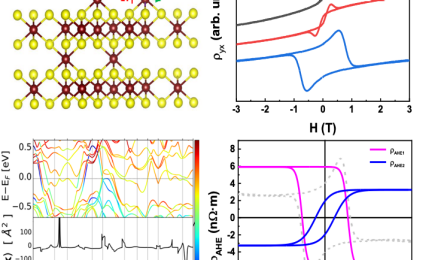
The unconventional anomalous Hall effect (AHE) in Cr2Te3, characterized by a sign change and humps and dips near the coercive field in its hysteresis, is attributed to an intrinsic mechanism dictated by spin canting of self-intercalated Cr cations, resulting in multiple band anti-crossings (Weyl-like nodes) near the fermi level.

PhD student Chiran Wijesundara contacting spin current injected single photon emitters that can be used for measurement beyond the Quantum noise limit.
Optimized higher-order photon state classification by machine learning
By Tim Thomay, PhD
Higher-order photon states can leverage quantum properties such as the photon number to reach fundamental detection uncertainties such as the Heisenberg quantum noise limit of detection. This has applications ranging from detecting dark matter to optimizing plant growth using a Quantum fingerprint (an example is shown in Figure 1). We recently published a novel way to classify higher-order photon emission using a machine learning model utilizing a 2D Convolutional Neural Network (CNN).
This allows for the rapid classification of multiphoton Fock states and thus determining the quantum state of light in quasi real-time. So far, the commonly used second-order correlation, g(2), is inadequate for assessing the quantum purity of higher photon Fock states and traditional characterization methods, such as Levenberg-Marquardt, require extensive photon detection events, resulting in longer measurement and computation times. We developed a novel scheme using specialized machine-learning hardware that allows us to determine the quantum characteristics of any light emitter directly on the measurement system. With this improvement we can create a quantum fingerprint of living biological systems that are injected with biological compatible quantum light emitters. We achieved this together with the group of Prof. Jim Berry in the UB Biology department. Since this novel measurement concept is universal, we hope to extend it to even more systems to have a broad impact in systems where classical spectrographic methods were used so far.

Quantum Fingerprint of a tobacco leaf in low light conditions. The newly developed quantum fingerprint can be used to shorten the cycle of the optimization of growth conditions of plants.
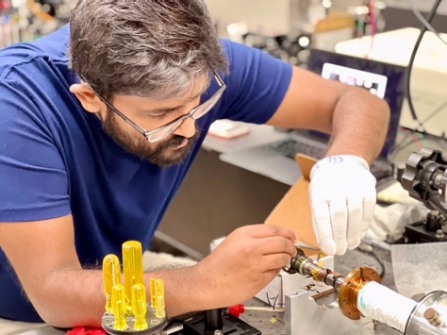
PhD student Chiran Wijesundara contacting spin current injected single photon emitters that can be used for measurement beyond the Quantum noise limit.
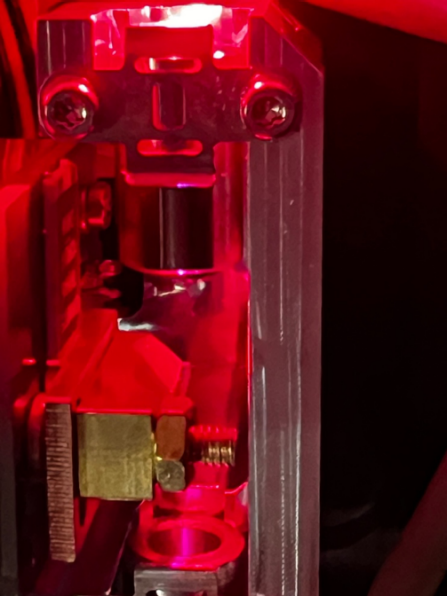
Ultrafast near-infrared laser pulses are being converted into the visible for excitation and characterization of Quantum light emitters.
Spin Information from Earth to Mars
By Igor Zutic, PhD
In spintronics, recognized by its success with magnetic computer hard drives and magnetic memories, information is represented by electron spin and by its proxy, the direction of magnetization. Spins oriented either along or against the magnetization axis, represent binary information 0 and 1. However, by taking electrons out of the ferromagnet, the spin information is quickly lost and cannot travel far. This major limitation can be overcome by using the spin-orbit coupling and the transfer of angular momentum from electron spin to the circularly polarized light or helicity.
A recent study, published in "Nature," demonstrated the crucial missing link by electrically modulating the magnetization to change the helicity of the emitted light. Igor Zutic, with co-authors of this work who have visited UB, Dr. Yuan Lu, University of Lorraine, France, and Prof. Nils Gerhardt, Ruhr University in Bochum, Germany, has participated in writing a related research proposal. The proposal, recommended for funding by the European Commission, envisions that the robust transfer of angular momentum to the helicity of light could enable a highly efficient spin information transfer to Mars.

Schematic depiction of spin information transfer to Mars via transfer of angular momentum to the helicity of light.
Department Events

Participants of Physics Graduate Research Symposium in Natural Science Complex. Photo credit: Murthy Ganapathy, Hao Zeng
Physics Graduate Research Symposium
By Wanyi Nie, PhD
On October 12, 2024, the department successfully hosted our first full-department Graduate Research Symposium in two decades. The goal of the event is to celebrate the research achievements of our graduate students, give them opportunities to present their own works, and expose our younger graduate students to the exciting research opportunities and projects that the department has to offer.
In his opening remarks, Prof. Sambandamurthy Ganapathy, Associate Dean of Research in the College of Arts and Sciences, offered students his deep insights and advices. He discussed current nationwide landscape and trends of physics PhDs and emerging opportunities, and diverse career resources available at UB. He emphasized the importance of identifying appropriate research areas and specialized research skills, joining a research group early, and navigating the job market based on evidences. Prof. Xuedong Hu, Department Chair, followed with highlights of research areas and recent achievements of the department. He encouraged students to always maintain their curiosity and work hard. Four faculty members, Profs. Wanyi Nie, Andrea Markelz, Herbert Fotso and Peihong Zhang, then introduced a wide range of research topics, from novel semiconductors, renewable energy, protein dynamics, biophysics of cyanobacteria, to nonequilibrium dynamics in quantum many body systems, to computational materials physics.
22 graduate students presented their work at the symposium, either through poster or oral presentations, including several first- and second-year graduate students. Faculty and students engaged in lively discussions and exchange of ideas, with faculty providing feedback to students on their project and presentation skills. The event was a testament to the vibrant, collaborative research atmosphere within the department and a growing and enthusiastic graduate student community.
Among all the outstanding presentations, Jeffrey Carvalho and Nitin Kumar won the Best Oral Presentation Award. Nawanath Budhathoki, Huai Chang and Naume Shentevski were selected for the Best Poster Award. Congratulations!
The enthusiasm and passion to perform research at the forefront of experimental and theoretical physics demonstrated by our students was contagious. While I was impressed by the talks given by our faculty members, the talks and posters presented by our students were incredibly engaging, and have both breadth and depth. In my opinion, they are all prize-worthy.
–Prof. Hao Zeng.
Participant students were equally enthusiastic.
The Physics Departmental Symposium, organized by Dr. Banerjee and Dr. Zeng, provided an excellent platform for me to showcase my research to fellow colleagues. Events like this are unique opportunities because they bring together faculty and students from various disciplines within physics. While presenting my poster, I received constructive feedback and ideas that I hadn't considered before—all in just two hours!! Additionally, it's important for researchers to occasionally feel connected to the bigger picture, and I believe that symposiums like this should be held annually.
– Meet Raval
The Physics Graduate Symposium held on October 12, 2024, was an exceptional event for new graduate students and first-time participants like me. It offered a valuable opportunity to learn about the ongoing research in the physics department from both faculty and fellow students, helping us identify our fields of interest. The enthusiasm of the participants highlighted the willingness of graduate students to showcase their research, share their work, and gain new insights from faculty and peers.
– Pratibha Khanal
The Graduate Studies Committee intends to make the Graduate Research Symposium a tradition for the department. We will continue to seek feedbacks from students and faculty alike to help us create more exciting events in the future.
A successful event like this Symposium is impossible to pull off without a lot of people working behind the scenes. The symposium was conceived by Prof. Priya Banerjee, our Director of Graduate Studies, helped by the organization committee of Profs. Wanyi Nie, Herbert Fotso, Dusan Sarenac, and Hao Zeng. Administrative Assistant Rachel Bolden, Department Administrator Nicole Pannullo, and the Graduate Studies Coordinator Amy Arends helped take care of the logistics. Many student volunteers assisted by setting up posters, coffee and foods, and helping with cleaning up. Thanks to all their contributions, the Symposium ran smoothly and successfully.
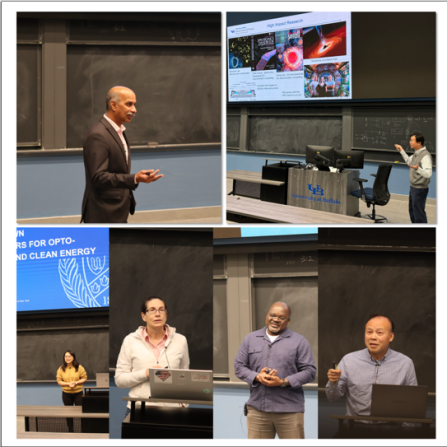
Welcome talks given by Prof. Ganapathy, Prof. Hu (top row). Faculty talks given by Profs, Nie, Markelz, Fotso and Zhang (bottom row). Photo credits: Hao Zeng
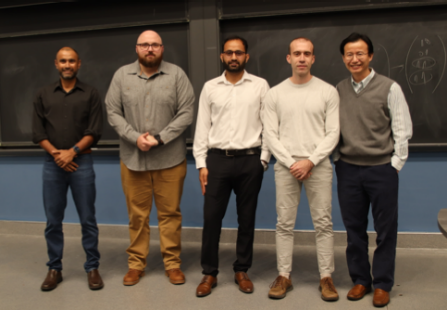
Best oral/poster awardees with Prof. Banerjee (left) and Prof. Hu (right). Photo credit: Hao Zeng
UB physics department has a vibrant graduate student community. These students are an essential part of our world-renowned faculty research programs. The GRS offered the perfect event to bring them together, fuel discussion and learning, and promote curiosity-driven science. The event was a celebration of our graduate students’ excellence.
– Prof. Priya Banerjee
Aurora visible near UB
By Wanyi Nie, PhD
On October 10, 2024, we observed intense Aurora over the night sky of UB campus, which was also visible in most areas of US. It started around 7pm on October 10 and lasted till early morning of October 11. The green northern light was visible around 9 pm, it then turned to intense colorful ribbons at around 10:30pm.
The aurora, also known as the Northern Lights, is commonly observed in high-latitude regions such as Alaska and Northern Europe. It is a natural light display caused by the ionization of atmospheric molecules by charged particles. Each year, typically from September to January, solar winds carrying these charged particles interact with Earth's atmosphere, producing the aurora.
You may wonder why can we see the aurora near Buffalo and other places in the US this time? The sun’s stormy power was charging up the auroras over Earth’s atmosphere beginning of October. The intense solar flares carried more density of charged particles and triggered a more sever geomagnetic storms that pushed the aurora towards further south, which were visible outside of the typical viewing regions.
Colors in the aurora are the result of charged particles interacting with atoms in the upper atmosphere at different altitudes: the most common green color comes from oxygen atoms at altitudes of 60-190 miles, while the beautiful red hues we saw last week are rarer, also coming from oxygen but at higher altitudes, 180-250 miles. Blue and purple colors are due to charged particles exciting the electrons in nitrogen. Auroras typically occur at high latitudes, near the North and South poles, carried by the Earth’s magnetic field. However, near the maxima of the Sun’s eleven-year cycle of solar activity, they are more frequently seen at lower latitudes as well. The current solar activity cycle peaks in early 2025, so we can expect more spectacular light shows over the next few months!
- Prof. William Kinney
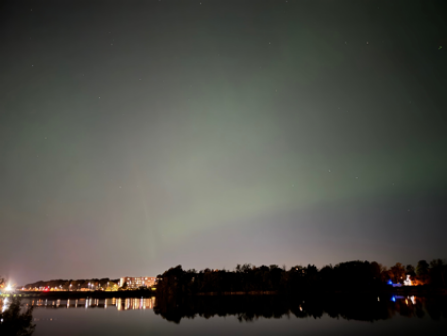
The photo was taken in front of the UB's Lake LaSalle on October 10, 2024, at around 9 p.m. when green light was visible.
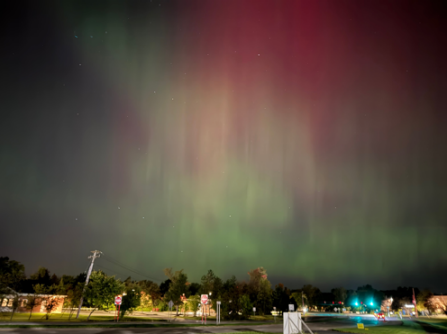
The photo was taken in front of the UB north campus entrance on October 10, 2024, at 10:30 p.m., when green and red lights were visible.

Prof. Ivan K. Schuller gives the 28th Moti Lal Rustgi lecture at UB.
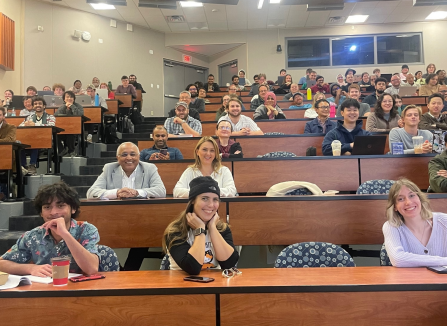
Part of the audience at the the 28th Moti Lal Rustgi lecture. The second row, center, shows members of Prof. Rustgi's family attending the lecture. Prof. Schuller took the photo.
2024 Moti Lal Rustgi Memorial Lecture
By Igor Zutic, PhD
On October 18, 2024, the physics department hosted the 28th Moti Lal Rustgi Memorial Lecture. The Moti Lal Rustgi Memorial Lecture Series was established in 1993 through a generous endowment from the Rustgi family to honor and remember former physics colleague Professor Moti Lal Rustgi. The lecture is given annually by distinguished researchers across a broad range of physics disciplines. As in previous years, the lecture was also attended by the Rustgi family and their friends. The 28th lecture in this series, titled “Neuromorphic Computing: Developing Quantum Materials for an Energy-Efficient Fault-Tolerant Computer, Inspired by the Human Brain,” was given by Ivan K. Schuller, Distinguished Professor of Physics at the University of California, San Diego. Professor Schuller, a renowned expert in experimental condensed matter physics is also the director of the of the Energy Frontier Research Center on Quantum Materials for Energy Efficient Neuromorphic Computing. The topic of Prof. Schuller’s lecture, closely related to the explosive growth in the artificial intelligence (AI), had an excellent timing. It quickly followed the announcement that pioneering works on Neural Networks which underlie current AI fever were recognized by the two Nobel Prizes in 2024. Prof. Schuller’s engaging presentation reminded us of some of the past computing machines, including the slide rule that he holds in the photograph. The other photograph, taken by Prof. Schuller, shows a part of the audience and his artistic interests as he is the recipient of a regional Emmy award for his movie “When Things Get Small”. Students had the opportunity to join Prof. Schuller for lunch, where they asked questions about research directions and career paths, continuing the event's tradition of fostering close student interaction with leading experts.
UB Physics Hosts High School Summer Program on Magnetism
By Hao Zeng, PhD
On July 26, 2024, the University at Buffalo (UB) Department of Physics successfully concluded its week-long High School Summer Science Program, an immersive exploration into the world of magnetism. Led by Dr. Hao Zeng, the Moti Lal Rustgi Professor of Physics at UB, and Professor Xuemei Cheng, Dean of Graduate Studies and Rachel C. Hale Professor at Bryn Mawr College, the program brought together a group of promising young scientists from the local community eager to deepen their understanding of physics through hands-on experiences.
Throughout the program, students engaged in laboratory experiments, investigating topics such as earth’s magnetic fields and magnetic hysteresis, while refining their data analysis skills. As part of their learning process, participants presented their findings and produced college-level lab reports, which were critiqued by the two professors. These activities nurtured a scientific mindset that will help them tackle complex real-world problems and improve their scientific communication skills.
The program also included exciting demonstrations, such as remote power transmission and the levitation of magnets by high-temperature superconductors, providing students with a real-world perspective on the practical applications of magnetic technologies. Additionally, participants had the opportunity to tour UB’s state-of-the-art nanofabrication facilities, offering a glimpse into advanced scientific research and technology development. At the conclusion of the program, participants received a certificate as a record of their achievements.
The assistance of students Priyanka, Liam Jones, and Jennifer Rittenhouse (BMC), along with department staff member Rachel Bolden, was crucial to the program’s success. The National Science Foundation and UB’s Department of Physics provided generous financial support, which is gratefully acknowledged.
Sustainable environmental systems
Professor Surajit Sen is working on developing a comprehensive understanding of how highly entangled natural and synthetic ecosystems work. In this context his current work has been on studying how to architecture sustainable complex dynamical systems. The studies are directly linked toward developing sustainable and resilient geographical regions. Currently he is involved in helping develop a cross disciplinary campus-wide effort to engage in basic and translational studies on sustainable environmental systems. His invited lecture on sustainable cities at the Centre for Technology Foresight of the Indian Institute of Technology Jodhpur, given in January 2024.
Related studies which fall within the domain of physics includes developing ways to detect infrasound in the context of animal communications and in the context of tsunamis, earthquakes and magma motion. Prof. Sen’s recent paper on the subject is Machado, L.P.S., Kowal, C., Bayma, R.S. and Sen, S., 2024, “Nonlinear dynamics of inverse tapered granular chains for mechanical amplification in voice frequency range.” The Journal of the Acoustical Society of America, 156(2).

Professor Surajit Sen is speaking as a featured speaker at the Sustainable Geo-communities Workshop in New Delhi, India, in June.
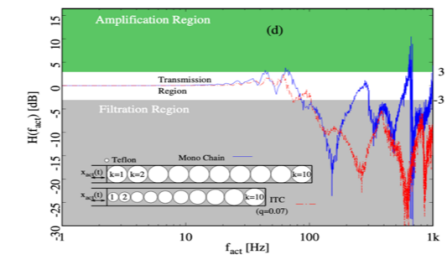
Certain granular structures (inset) allow amplification of very low frequency sounds. Larger chains allow amplification of progressively lower frequencies which are typically very difficult to detect.
Dr. Will Kinney Appears at World Science Festival
The World Science Festival in New York is a science and technology outreach event internationally known for its annual week-long live event series held in New York City. Co-founded by Tracy Day and bestselling science author Brian Greene, WSF is a premier platform bringing transformative ideas from renowned scientists, artists, and intellectuals to the public, both live and online. This year, UB professor Dr. Will Kinney joined Dr. Greene on June 1 at the Gerald W. Lynch Theater at John Jay College in New York for Infinite Beginnings? Time in Cutting Edge Cosmology. Focusing on recent work by Kinney and graduate student Nina Stein, Kinney and Greene discussed big questions in cosmology, such as: Did the universe have a beginning? Is our universe the only one, or is there a “multiverse” of other universes, as suggested by inflationary cosmology.

Prof. Greene interviews Prof. Kinney at the World Science Festival in New York.
Faculty Recognitions and Awards
Faculty Recognitions
Multiple Physics faculty members received external awards in recognition of their excellence in research.
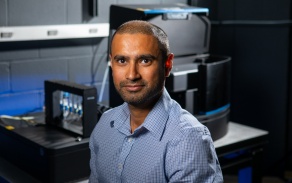
Professor Priya Banerjee
Banerjee has received the UB 2023-24 President Emeritus and Mrs. Meyerson Award for Distinguished Undergraduate Teaching and Mentoring. Each year, the Meyerson Award recognizes the impact quality mentoring has on the student experience and academic achievement. The world-class research program in biophysics Prof. Banerjee has established since he joined UB in 2017 provides the ideal environment for training students at all levels. His exceptional dedication to training and mentoring students together with a rich research environment allows students to excel. His undergraduate students frequently coauthor publications from his research group. Two of his undergraduate students, Hanna Seppala and Paul Dewan, won the prestigious Barry M. Goldwater Scholarship, which is highly unusual in any institution in such a short period of time. Since then, Paul Dewan has been accepted as a graduate student by Harvard and has received the prestigious NSF Graduate Research Fellowship.

Professor Xuedong Hu
Hu has received the SUNY Chancellor’s Award for Excellence in Faculty Service which recognizes “the consistently superior service contributions of full-time teaching faculty” sustained over multiple of years. Professor Hu has served as the department’s Director of Graduate Studies (DGS) with great distinction and leadership for more than a decade and was recently appointed Chair of the Physics department. His selfless services to the Department, UB and SUNY resulted in significant improvements in education and research. During his tenure as DGS, he oversaw a reform of the department’s graduate program which got rid of a rigid and outdated admission process for graduate students to enroll in the Ph.D. program and has prevented any significant adverse effect from numerous unexpected difficulties he encountered, especially during the COVID-19 pandemic. For example, he organized the Graduate Studies Committee and the faculty to explore better ways to advertise the physics graduate program, more effectively identify possible students, and communicate with them once they expressed interests or showed intentions to join UB. These activities contributed greatly to the smooth operation in the department and resulted in the admission of many excellent students. His outstanding service was not limited to administrative activities in the Department. Professor Hu is a world-leading expert in quantum computing, and when he joined UB in 2002 he was the first in the Department, and at UB, working in this research field. In recent years, this area has been increasingly recognized as being of great importance to future science and technology. At the federal level, many funding agencies, including DoD and NSF, have dedicated programs for this field, followed by similar programs in the State of New York. Over the years, Prof. Hu made good use of his expertise to put UB on the map so that UB is now in a position where a substantial team of researchers can pursue joint state and federal grants.
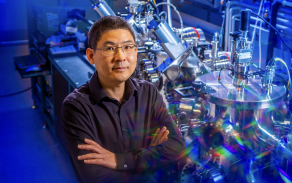
Professor Hao Zeng
Zeng, Moti Lal Rustgi Professor in Physics, has been elected a 2024 Fellow of the American Physical Society (APS). The citation reads that the award is being made "For pioneering contributions in the development of nanoscale magnetic materials, including core-shell nanoparticles, nanocomposites, and 2D heterostructures, driven by their fundamental physics and applications in the realms of energy, information, spintronics, and biomedicine.” APS Fellowships are a great honor, recognizing excellence in physics and exceptional service to the physics community. Each year no more than 0.5 percent of the society non-student membership is recognized by their peers for election to Fellow of the American Physical Society. This year, 149 Fellows were selected internationally and recognized for their contributions to science. Professor Zeng is an international leader in materials science and physics, with pioneering work in magnetic nanoparticles, data storage and permanent magnets. An experimentalist who combines physics and chemistry to produce materials on the nanometer scale for various applications, he has led research in novel magnetic nanostructures, 2D materials and chalcogenide semiconductors. Throughout his academic career at UB, Professor Zeng has been funded by the National Science Foundation, the Department of Defense, the Department of Energy, the SUNY Applied Materials Research Institute, and he has received a prestigious NSF CAREER award in 2006. He is also Editor of the Journal of Magnetism and Magnetic Materials and serves on the Committee on Memberships for the American Physical Society.
Faculty Awards
Professors Rappoccio, Kharchilava, and Iashvili have been awarded a $1.6M grant from the National Science Foundation (Award Number 2411783) entitled "High Energy Physics Research at the CMS Experiment” to continue their research at the Large Hadron Collider (LHC) on the Compact Muon Solenoid (CMS) experiment at CERN in Geneva, Switzerland. The group has also added two new members to their faculty, Profs. Christine McLean and David Yu, who will be joining the department in January 2025. This research will search for subtle signatures of Beyond Standard Model (BSM) physics using advanced methods for identifying rare signals and addressing systematic uncertainties. These include detailed studies of the properties of the Higgs boson, extending the search program for BSM physics, and systematically improving techniques to maximize the physics potential. This research will also extend the capabilities of the CMS tracking detector to handle conditions at the High Luminosity LHC, extend its geometric coverage, and add tracking information to the far-forward particle flow algorithm. In addition, studies will be performed on the properties of highly Lorentz-boosted SM Higgs bosons decaying to bottom quark-antiquark pairs to fully explore the Higgs coupling to quarks, as well as to search for new phenomena in unexplored signatures at higher masses, such as new heavy vector bosons. This program will also develop and maintain object reconstruction for heavy- and light-flavor jets, as well as perform measurements of SM physics processes including production of W/Z/gamma in association with heavy flavor jets, and detailed understanding of the quantum chromodynamic evolution of jets.
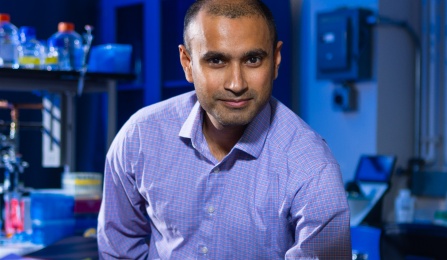
The RNA World hypothesis states that life on Earth originated with RNA molecules capable of self-replication. Over millions of years, this process is thought to have led to the development of DNA and proteins, which eventually combined with RNA to form cells. Dr. Priya R. Banerjee, an associate professor of physics at the University at Buffalo, has been working on developing physical models of how RNA molecules, one of the key building blocks of life, form liquid-like droplets when faced with heat stress. This discovery was reported by Dr. Banerjee and his collaborators last year in a research article published in Nature Chemistry. Banerjee’s research has led to a new hypothesis that RNA’s inherent ability to form liquid-like droplets at elevated temperatures could have shielded it from harsh environments and helped compartmentalize its functions. To test this bold idea, Banerjee has recently received a seed grant from the Hypothesis Fund which will allow him and his team to explore the “droplet” state of RNA and their possible role in the origin of life on Earth.
The project, titled "Liquid RNA Condensates as Programmable Scaffolds for Compartmentalization and Catalysis," was chosen for the boldness of the science and Banerjee’s willingness to pursue high-risk, groundbreaking ideas. The Hypothesis Fund provides seed grants to support innovative, early-stage research that often lacks preliminary data, targeting high-risk, high-reward ideas that may not otherwise receive funding. According to Dr. Taekjip Ha, a Hypothesis Fund scout and a prominent researcher at the Howard Hughes Medical Institute and Harvard Medical School, Banerjee’s work offers fresh perspectives on the origin of life by exploring the biophysical properties and self-organizing behaviors of RNA. His hypothesis has the potential to not only address unresolved questions about how life began with RNA but also to inform future RNA-based medical treatments.
Department’s helium gets students’ eclipse weather balloon into the air
By John Cerne, PhD
People in Buffalo had a rare opportunity to observe a total solar eclipse on April 8, 2024. However, according to data from NASA’s MERRA-2 model-based reconstructions, we typically have a 20% chance of clear skies in April. To overcome this challenge and to provide a different view of the eclipse, several members of UB’s Students for the Development and Exploration of Space (SEDS), contacted me in the fall of 2023 about launching a camera-carrying weather balloon to view the eclipse from high altitude, above any clouds that may be present over Buffalo on April 8.
They had thoroughly researched this problem and had a very detailed technical plan, which is not surprising since SEDS designs and builds its own rockets, including the fuel, from scratch. What they needed from the Physics Department was helium gas to inflate their weather balloon. Fortunately, the Department has a large reserve of helium gas that was recollected from low-temperature experiments using liquid helium in Fronczak Hall when the Cryogenics Facility was running. In more recent years, demand for liquid helium dramatically fell as most new cryogenic systems now use a self-contained helium gas recovery and liquefaction system, so the Cryogenics Facility was shut down. However, we saved the recovered helium gas, and this was a great opportunity to put a small fraction of it to good use. I first met with Nicholas McNally (aerospace engineering graduate student) and Krish Patel (Physics BS student) in September 2023 to discuss our helium gas supply. A major concern was that that since our helium gas was recovered at ambient pressure in labs through latex hoses and piped throughout Fronczak in PVC tubing, it was not of the highest purity and could have been contaminated by air before it was compressed into high pressure tanks. At the low temperature of high altitudes, any impurities in the gas such as water vapor, can freeze and cause the balloon’s thin latex membrane to crack prematurely. The students filled several small balloons with our helium gas and put them in a freezer to check if there was any water vapor in the gas, which would have frozen. The freezer results were promising, and the first real test of our helium gas and the students’ balloon/payload design occurred on March 13 when a test balloon was launched. The payload included a Go-Pro camera, chemical handwarmer packets to keep the batteries from freezing, a DIY altimeter, and a GPS locator/transmitter to keep track of position of the payload so that its path can be recorded, and it can be found after it lands. Typically, weather balloons expand as they rise due to the surrounding air pressure of the atmosphere decreasing, eventually rupturing at altitudes between 60,000 and 110,000 feet. Then the payload falls back to earth suspended beneath a parachute.
The launch of the test balloon was successful, and the payload travelled around 100 miles to the southeast, landing NEAR (we’ll get back to this later!) Seneca Lake. The flight path is shown in picture below. This experience provided important lessons, and the students were confident about the eclipse launch on April 8. UB’s President, Provost, and SEAS Dean were at the launch, which went according to plan. Unfortunately for viewers on the ground, there was significant cloud cover that obscured the eclipse. This is exactly why SEDS planned this flight! Unlike the test flight, which landed short of Seneca Lake, the payload on April 8 (with all the precious and irreplaceable video data stored in the camera!) landed IN the lake. Our intrepid students prepared for this possibility by putting floatation devices on the payload and the recovery team brought its own kayak to fish the payload out of the lake. Fortunately, the students were able to dry out the camera and recover the video. The video is spectacular – youtube link provided at end of the article.
In addition to getting a clear view of the eclipse above the clouds, the high perch of the balloon camera allowed us to see the moon’s shadow move across the clouds. A photo of totality is included below. Unfortunately, the camera’s resolution couldn’t separate the solar corona from the dark moon, so the sun appears bright in the photo. However, one can see the darkness of space surrounding the sun as well as the planet Venus. This is the first total eclipse that I have experienced and seeing the sun as a heavenly body, a star, surrounded by dark empty space (not just a bright disk in the blue sky, being partially blocked) was the most amazing part.
I think it is fitting that helium, which was discovered in 1868 during a solar eclipse through its bright spectral emission lines in the solar corona and which is named after the sun, was a key element in SEDS’ dramatic exploration of our solar eclipse on April 8. I must admit that the numerous partial eclipses that I have seen in the past (some that were less than 20% away from totality) cannot be compared to a total eclipse. The total eclipse was a completely different experience for me and I’m glad the SEDS was able to make it even more special!
Inflating the test balloon near UB’s Lake LaSalle on March 13, 2024. The helium cylinder is in the center, in front of the balloon. Photo by John Cerne.
Left to right: Provost Weber, SEAS Dean Kemper Lewis, Parth Agrawal, Ruben Jovel, Brian Syzbist, Jaynie Tercovich, Kyle Palmatier, Nick McNally, Ryan Tyznar, Dario Tringali,* Krish Patel,* Arnav Mohapatra, and President Tripathi at the balloon launch on April 8. *Indicates physics majors. Photo by Grace Testa.
Prof. Salvatore Rappoccio and Mr. Sanchez at the CSTEP Summer Research Symposium (right insert), as well as some of his fellow interns from the CSTEP cohort.
CSTEP research by Physics undergraduate
By Salvatore Rappoccio, PhD
As part of the Collegiate Science and Technology Entry Program (CSTEP), Physics Department undergraduate Diego Sanchez has been working on using artificial intelligence techniques to measure the production rate of hadronic jets at the Large Hadron Collider in Geneva, Switzerland. Prof. Salvatore Rappoccio has been his mentor for the project. Mr. Sanchez presented his research at CSTEP summer research Symposium at Jacobs School of Medicine and Biological Sciences on July 25, 2024.

Some of our graduating seniors at the commencement ceremony in Spring 2024.
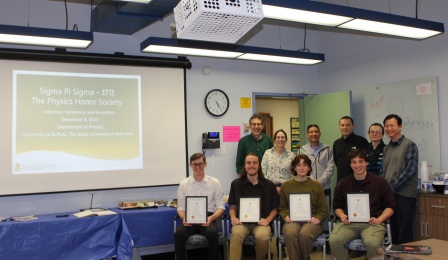
Sigma Pi Sigma induction ceremony. Our inductees were seated in the front row, from left to right: Charles Freeman, Nicholas West, Lea Kyle, and Dario Tringali. Photo by Mariam Ashour.

Nalin Cooper-Sherrow (advisor Prof. T. Thomay) gave a presentation at the UB Undergraduate Excellence Symposium about enabling quasi-real-time characterization of higher-order quantum mechanical states utilizing custom artificial intelligence hardware.
Graduate Student Awards
Physics Graduate Student Memorial Fellowship
- Aly Abuelmaged
- Chang Huai
- Amartya Sengupta
- Shreekanth Shankaran
John Ho & Martha Leung Scholarship
- Xi Chen
- Budhathoki
- Daniele Gaggero
- Nitin Kumar
Om and Saraswati Bahethi Scholarship (2023-2024)
- Xi Chen
- Gabriele Fiore
- Haolei Hui
- Guangpeng Xu
Outstanding Teaching Assistants (2023-2024)
- Daniele Gaggero
- James McAllister
College of arts and sciences Dissertation Fellowship
- Jiayu Cao
Silvestro Scholarship (2023)
- Muhammad Haider Abbas
- Daniele Gaggero
- Chang Huai
- Nitin Kumar
- Vedant Subhish
- Shreekanth Shankaran Yuvarajan
- Yifan Zhang
Undergraduate Awards
Om and Saraswati Bahethi Foundation Scholarship
- Mars Anderson
- Krish Patel
- Dario Tringali
- Carter Weidman
Outstanding Seniors (2023-2024)
- Krish Patel
- Dario Tringali
- Nicholas West
Sekula Scholarship (2023-2024)
- Mars Andersen
- Anne Campbell
- Nalin Cooper-Sherrow
- Anthony Gullo
- Thomas McEntire
- Olivier Mitton
- Dario Tringali
- Corey J. Young
Sigma Pi Sigma Inductees (2023-2024)
- Aaron D'Angelo
- Charles Freeman
- Lea Kyle
- Dario Tringali
- Nicholas West
Recent Graduates
Physics PhD
Amani Almutairi (Summer 24)
Advisor: Athos Petrou
Thesis Title: “Photoluminescence Study of CsPbBr3 Perovskite for Spin Light Emitting Diode”
Margaret Morris (Spring 24)
Advisor: Salvatore Rappoccio
Thesis Title: “Search for ttbar resonances in the all-hadronic channel with the CMS Detector using Run 2 legacy dataset”
Luke Pendo (Spring 24)
Advisor: Xuedong Hu
Thesis Title: “An open source software package to compare and extend effective mass models of the phosphorus donor in silico.”
Greis Cruz Reyes (Spring 24)
Advisor: Peihong Zhang
Thesis Title: “Defect-enabled Novel Properties: Photocatalyst, Intermediate Band and Magnetism”
Kim Youngjin (Spring 24)
Advisor: Ciaran Williams
Thesis Title: “Study of A + jet@NNLO in QCD with MCFM Framework”
PHYSICS Master's
- Mohamed Fawzy Abbas Aly (Summer 24)
- Sangit Baskota (Summer 24)
- John Clayton (Summer 24)
- Dylan Delgado (Fall 23)
- Ahmed Magdy Abdelmaboud Elshahawy (Summer 24)
- Courtney Fitzgerald (Spring 24)
- Muye He (Fall 23)
- James McAllister (Spring 24)
- Alexander Mcnulty-Romaguera (Fall 23)
- David Monroe (Spring 24)
- Sushruth Muralidharan (Summer 24)
- Shreekanth Yuvarajan (Fall 23)
- Yifan Zhang (Spring 24)
PHYSICS Bachelor's
- Sayeed Ahmed (Physics BS, Cum Laude, Summer 24)
- Mars Andersen (Physics BS with distinction, Magna Cum Laude, Spring 24)
- Mark Bogacki (Physics BS, Spring 24)
- Jake Di Nardo (Physics BS, Fall 23)
- Chris Durnien (Physics BA, Spring 24)
- Anthony Gullo (Mathematical Physics BS with high distinction, Magna Cum Laude, Spring 24)
- Thomas Hahn (Physics BS with distinction, Magna Cum Laude, Fall 23)
- Christopher Hanley (Physics BS, Cum Laude, Spring 24)
- Linxuan Hu (Physics BS, Fall 23)
- Justin Janiszewski (Physics BA, Spring 24)
- Neng Ji (Engineering Physics BS, Spring 23)
- Benjamin Morley (Physics/PhysicEd BA, Spring 24)
- Jennifer Lynne Newman (Physics BS with high distinction, Magna Cum Laude, Spring 24)
- Zaw Oo Ko (Engineering Physics BS, 24)
- Cheng Yue Ong (Physics BA with distinction, Cum Laude, Spring 24)
- Aashil Patel (Physics BS, Spring 24)
- Krish Patel (Physics BS with highest honors and distinction, Summa Cum Laude, Spring 24)
- Dario Tringali (Engineering Physics BS with highest distinction, Summa Cum Laude, 24)
- John Verdi (Mathematical Physics BS, Cum Laude, Spring 24)
- Alyssa Warrior (Physics BA, Fall 23)
- Carter Weidman (Physics BS with high distinction, Magna Cum Laude, Spring 24)
- Nicholas West (Physics BS with highest distinction, Summa Cum Laude, Spring 24)
- Trey Wojnar (Mathematical Physics BS with high distinction, Magna Cum Laude, Spring 24)
Thank you for your support of the Department of Physics. With the support of alumni and friends, we can provide vital resources to enhance our department and provide support for students, research projects and programs. We are grateful for your generosity.
You can support your department and help to provide for our students by making a gift online.

